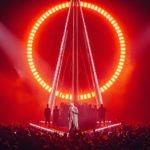The electrician is master of the theatre domain
“It seems the expectation is that an entertainment electrician should be an engineer, licensed electrician and theatre technician.” Virginia Croskey, an adjunct professor at Prince George Community College in Largo, Md., wrote those words after taking a two-day entertainment electrician’s course. The course is designed to teach the principles behind the practice of being an entertainment electrician. Yes, Virginia, there is more to the entertainment electrician than meets the eye.
For many years I thought a master electrician in the entertainment industry was a person who dealt exclusively with electricity and power distribution. Silly me. I’m a slow learner — that I’ll admit — but once I met some working master electricians, like Rob Baxter and his brother Rick, it slowly dawned on me that these guys are nothing like those electricians who show up on the job site with a lunch pail, a tool belt and a plumber’s crack. No, these guys are electricians the way Tiger Woods is a golf hack. They’re the Terminators of the industry, the table-top fusion generators of the theatre set. A good master electrician has the brains of an engineer, the knowledge of a technician and the skill of an electrician, but without the beer belly (in most cases). The course was designed to prepare the entertainment electrician to be a Baxter or a, well, another Baxter.
Take, for example, the job description for a master electrician at the University of Southern California that I found on the Internet. Among the list of job responsibilities are these gems:
“Assists in the hanging of light plots…” These days, lighting plots can have more technology than Silicon Valley. They might involve conventional fixtures, automated fixtures, data distribution, special effects and control systems. It might also involve setting up a wireless network, fiber optic cabling, Ethernet systems, media servers or digital luminaires.
In order to correctly hang a lighting plot today, you should be able to make heads or tails of lighting plots, riser diagrams, panel schedules and/or shop orders. You should be able to interconnect all the nuts, bolts, wires and paper clips to make it work seamlessly. And if any of these components or systems is not working correctly, someone has to diagnose and fix the problem. Do you have any idea who that might be?
You guessed it. Also listed in the job responsibilities of the master electrician at USC, and doubtlessly other theatres, is this: “Assists in the maintenance of all specialized lighting equipment in the School’s theatres.” I don’t know about you, but I’ve never met a commercial electrician who would even know from which end of a digital luminaire the light comes. And don’t even think about asking for help with your network, be it DMX512, ArtNet, SandNet, Ethernet or a basketball, volleyball or fishing net. Well, maybe a fishing net.
And there’s also this: “Assists students in observing theatre safety rules.” If you can read between the lines you might guess that those lines are probably rigging lines, the same ones the master electrician needs to know about, if only in a basic way. No, the ME doesn’t have to be a certified rigger, but there are those who are. And it goes without saying that the ME should know enough about electricity to be not dangerous.
Another of the listed duties is, “Creates lighting designs.” Yes, plenty of master electricians design lighting plots. That involves a completely different side of the brain than tying in the feeder cable, yet many an ME is proficient at it.
Lastly, the USC master electrician also “performs other related duties as assigned or requested. The University reserves the right to add or change duties at any time.” In other words, whenever there’s a problem that no one else can fix, it’s up to you, my master electrician friend.
I’ve always thought the “master electrician” moniker was misleading. It might be more appropriate to call them a “master technician” or “master magician,” but someone might have to fill out some paperwork for that to happen. So I’m putting my money on keeping the status quo.
But if a master electrician has a lot of responsibility, what does that mean for a production designer? If you want to list the responsibilities of a production designer, you can start with the responsibilities of a master electrician and go from there. Not that a designer would be responsible for the power distro or rigging, but certainly a good one knows their way around the entire production. The most successful production designers I know are whizzes with the computer — CAD, visualization, rendering and animation for starters — they’re great communicators, they understand the ins and outs of the production, and they have great imaginations. Whether they work with WYSIWYG, VectorWorks, LD Assistant or AutoCAD, they typically have a mastery of many other software tools like Cinema 4D, 3D Studio Max, Poser, After Effects and a handful of other tools that help them create, illustrate, demonstrate, motivate and facilitate their ideas.
How can anyone know everything about everything in a production? You can’t. But it sure helps if you are curious, filled with wonder and ask a lot of questions. It’s virtually impossible to ask a question without learning something in return. And don’t forget to play at work. Playing has a way of releasing your inner child and setting yourself on a course of discovery.
In short, a good production designer or master electrician has the mind of a child but behaves like an adult. Now if you’ll excuse me, I’m going to ask my mom if I can finish watching Sponge Bob Square Pants.
Put your Wii down for a minute and e-mail the author at rcadena@plsn.com.


